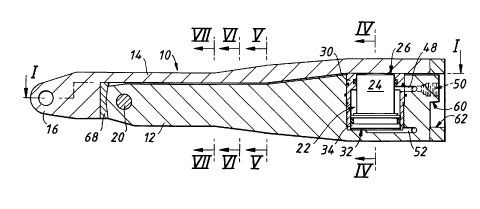Some of the information on this Web page has been provided by external sources. The Government of Canada is not responsible for the accuracy, reliability or currency of the information supplied by external sources. Users wishing to rely upon this information should consult directly with the source of the information. Content provided by external sources is not subject to official languages, privacy and accessibility requirements.
Any discrepancies in the text and image of the Claims and Abstract are due to differing posting times. Text of the Claims and Abstract are posted:
| (12) Patent: | (11) CA 2018610 |
|---|---|
| (54) English Title: | PIPE BURSTER |
| (54) French Title: | RUPTEUR DE CANALISATION |
| Status: | Deemed expired |
| (52) Canadian Patent Classification (CPC): |
|
|---|---|
| (51) International Patent Classification (IPC): |
|
| (72) Inventors : |
|
| (73) Owners : |
|
| (71) Applicants : | |
| (74) Agent: | GOWLING WLG (CANADA) LLP |
| (74) Associate agent: | |
| (45) Issued: | 1998-06-02 |
| (22) Filed Date: | 1990-06-08 |
| (41) Open to Public Inspection: | 1990-12-09 |
| Examination requested: | 1996-03-27 |
| Availability of licence: | N/A |
| (25) Language of filing: | English |
| Patent Cooperation Treaty (PCT): | No |
|---|
| (30) Application Priority Data: | ||||||
|---|---|---|---|---|---|---|
|
A pipe burster for cracking gas and other pipes
preparatory to inserting a replacement pipe in the passage
so formed. The burster comprises an elongated body
tapering in the lengthwise direction and made up of first
and second parts (12,14) extending in said direction. The
parts are connected by a transverse pivot pin (20). The
first part (12) is received within the second part and
carries a piston and cylinder(22)by which the parts are
separable. The circumference of the body is substantially
a closed curve and within the length of the first part the
circumference is increased by said separation. Therefore
the burster makes a clearance by said separation into
which the burster can be advanced. In a modification more
than one piston and cylinder is provided.
Dispositif d'éclatement de tuyaux servant à fragmenter des tuyaux de transport de gaz et d'autres substances avant l'introduction d'un tuyau de remplacement dans le passage ainsi formé. Le dispositif d'éclatement comprend un corps allongé, effilé dans le sens de la longueur et composé d'une première partie et d'une deuxième partie (12, 14) se prolongeant dans la dite direction. Les parties sont raccordées par un pivot transversal (20). La première partie (12) est reçue dans la deuxième partie et elle porte un piston et un cylindre (22) grâce auxquels les parties peuvent être séparées. La circonférence du corps est sensiblement une courbe fermée et, en deçà de la longueur de la première partie, la circonférence est augmentée par la dite séparation. Ainsi, le dispositif d'éclatement établit un espace, grâce à la séparation, dans lequel le dispositif d'éclatement de tuyau peut avancer. Dans une variante de l'invention, on trouve plus d'un piston et plus d'un cylindre.
Note: Claims are shown in the official language in which they were submitted.
Note: Descriptions are shown in the official language in which they were submitted.

For a clearer understanding of the status of the application/patent presented on this page, the site Disclaimer , as well as the definitions for Patent , Administrative Status , Maintenance Fee and Payment History should be consulted.
| Title | Date |
|---|---|
| Forecasted Issue Date | 1998-06-02 |
| (22) Filed | 1990-06-08 |
| (41) Open to Public Inspection | 1990-12-09 |
| Examination Requested | 1996-03-27 |
| (45) Issued | 1998-06-02 |
| Deemed Expired | 2004-06-08 |
There is no abandonment history.
| Fee Type | Anniversary Year | Due Date | Amount Paid | Paid Date |
|---|---|---|---|---|
| Application Fee | $0.00 | 1990-06-08 | ||
| Registration of a document - section 124 | $0.00 | 1991-02-06 | ||
| Maintenance Fee - Application - New Act | 2 | 1992-06-08 | $100.00 | 1992-05-25 |
| Maintenance Fee - Application - New Act | 3 | 1993-06-08 | $100.00 | 1993-05-25 |
| Maintenance Fee - Application - New Act | 4 | 1994-06-08 | $100.00 | 1994-05-25 |
| Maintenance Fee - Application - New Act | 5 | 1995-06-08 | $150.00 | 1995-05-25 |
| Maintenance Fee - Application - New Act | 6 | 1996-06-10 | $150.00 | 1996-05-24 |
| Maintenance Fee - Application - New Act | 7 | 1997-06-09 | $150.00 | 1997-05-23 |
| Final Fee | $300.00 | 1998-01-28 | ||
| Maintenance Fee - Application - New Act | 8 | 1998-06-08 | $150.00 | 1998-05-25 |
| Maintenance Fee - Patent - New Act | 9 | 1999-06-08 | $150.00 | 1999-05-12 |
| Maintenance Fee - Patent - New Act | 10 | 2000-06-08 | $200.00 | 2000-05-15 |
| Maintenance Fee - Patent - New Act | 11 | 2001-06-08 | $200.00 | 2001-05-16 |
| Maintenance Fee - Patent - New Act | 12 | 2002-06-10 | $200.00 | 2002-05-15 |
Note: Records showing the ownership history in alphabetical order.
| Current Owners on Record |
|---|
| BG PLC |
| Past Owners on Record |
|---|
| BRITISH GAS PLC |
| CARRUTHERS, ALEC REGINALD |